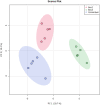Fungal consortium of two Beauveria bassiana strains increases their virulence, growth, and resistance to stress: A metabolomic approach
- PMID: 35834517
- PMCID: PMC9282594
- DOI: 10.1371/journal.pone.0271460
Fungal consortium of two Beauveria bassiana strains increases their virulence, growth, and resistance to stress: A metabolomic approach
Abstract
The use of two or more microorganisms in a microbial consortium has been increasingly applied in the biological control of diseases and pests. Beauveria bassiana is one of the most widely studied fungal species in biological control, yet little is known about its role in fungal consortiums. In a previous study, our group found that a consortium formed by two strains of B. bassiana had significantly greater biocontrol potential against the polyphagous caterpillars Duponchelia fovealis (Lepidoptera: Crambidae) than either strain on its own. In this study, we use GC-MS and LC-MS/MS to evaluate and discuss the metabolomics of the consortium. A total of 21 consortium biomarkers were identified, corresponding to 14 detected by LC-MS/MS and seven by GC-MS. Antioxidant and anti-inflammatory mechanisms are the main properties of the metabolites produced by the consortium. These metabolites can depress the insect's immune system, increasing its vulnerability and, hence, the fungal virulence of the consortium. In light of these results, we propose an action model of insect mortality due to the metabolites secreted by the consortium. The model includes the inhibition of defense mechanisms such as pro-inflammatory interleukin secretion, cell migration, cell aggregation, Dif, Dorsal and Relish gene transcription, and JAK/STAT and JNK signaling pathways. It also promotes the cleaning of oxidative molecules, like ROS, NOS, and H2O2, and the induction of virulence factors.
Conflict of interest statement
The authors have declared that no competing interests exist.
Figures






References
-
- Pell JK, Hannam JJ, Steinkraus JJ. Conservation biological control using fungal entomopathogens. Biol. Control. 2010, 55:187–198.
-
- Khachatourians GG, Qazi SS. Entomopathogenic Fungi: Biochemistry and Molecular Biology. In: Brakhage AA, Zipfel PF, editors. Human and Animal Relationships: The Mycota VI. 2nd ed. Saskatoon: Springer-Verlag; 2008. pp.33–61.
MeSH terms
Substances
LinkOut - more resources
Full Text Sources
Research Materials
Miscellaneous

